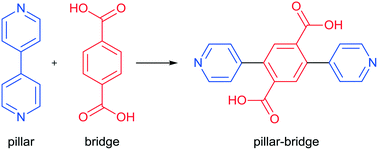A heterofunctional ligand approach for the preparation of high connectivity coordination polymers: combining a “bridge” and “pillar” in one ligand†
Abstract
Two of the most successful strategies for the preparation of three-dimensional coordination polymers and MOFs are reticular synthesis and pillaring. Here we present a new approach which combines aspects of both of these by employing a heterofunctional dicarboxylic and dipyridyl ligand, 2,5-di(pyridin-4-yl)terephthalic acid (H2L). The reaction of H2L with zinc(II) produces a non-interpenetrated 3D coordination polymer [ZnL(H2O)]n.

- This article is part of the themed collection: Introducing the CrystEngComm Advisory Board and their research


 Please wait while we load your content...
Please wait while we load your content...